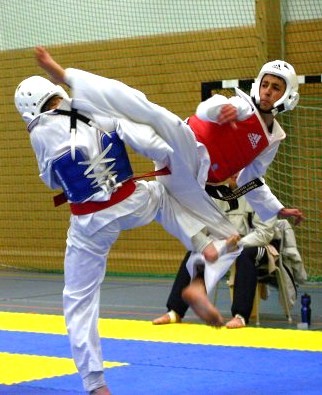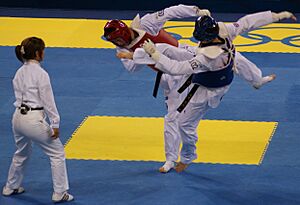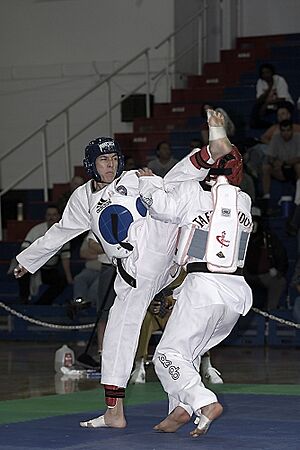Taekwondo facts for kids

A World Taekwondo sparring match
|
|
| Also known as | TKD, Tae Kwon Do, Tae Kwon-Do, Taekwon-Do, Tae-Kwon-Do |
| Focus | Striking, kicking |
| Hardness | Full-contact (WT), Light and medium-contact (ITF, GTF, ATA, TI, TAGB) |
| Country of origin | |
| Parenthood | Mainly Taekkyon and Shotokan Karate. Slight influence of Chinese martial arts |
| Olympic sport | Since 2000 (World Taekwondo) |
Taekwondo (say "TIE-kwon-DOE") is a cool martial art from Korea. It's a way of fighting that uses your hands and feet. You learn to attack and defend yourself. Sometimes, you might even use your fingertips, elbows, or knees!
Taekwondo is super popular in South Korea. It's even their national sport! The kyeorugi (sparring) part of Taekwondo is an event in the Olympic Games.
The name "Taekwondo" has a special meaning:
- 태 (Tae) means "to strike with the foot" (like a kick).
- 권 (Kwon) means "to strike with the hand" (like a punch).
- 도 (Do) means "way" or "path."
So, Taekwondo means "the way of the foot and the fist."
Even though Taekwondo has roots in old Korean martial arts, it's only been around in its current form for about 50 years. It became an Olympic exhibition sport in Seoul in 1988 and Barcelona in 1992. Now, it's a full Olympic competition sport!
Contents
What Makes Taekwondo Special?
Taekwondo is famous for its amazing kicks. This makes it different from other martial arts like karate. Kicking is important because your leg is the longest and strongest part of your body. A good kicker can hit an opponent from farther away and with more power, keeping themselves safer.
Practice Forms: Poomse
One important exercise in Taekwondo is doing poomse (say "POOM-seh"). These are like practice routines, similar to katas in karate. Poomse are set groups of defense and attack moves. They help you imagine fighting different opponents. These forms are linked to the different belt levels you earn. Doing poomse helps you get better at balance, flexibility, speed, and controlling your movements.
Mind and Body Power
Taekwondo is a great sport and exercise for everyone, no matter their age or gender. It helps you build strength, speed, balance, flexibility, and stamina. It also helps you focus your mind. For example, breaking boards shows how your mind and body work together. To break a board with your hand or foot, you need to master the physical technique. You also need to focus all your energy into that one spot.
The History of Taekwondo Belts
Some things in Taekwondo have changed over time, but respect has always been a huge part of it. Without respect, Taekwondo wouldn't be the amazing art it is today.
One thing that has changed is the belt system. The original colors are still used. But now, every time you pass a test, you either get a new belt or a stripe on your current belt.
Legend says that long ago, there was only one belt. But it still showed different colors!
- White was the color of the belt when it was new.
- Yellow appeared as sweat soaked into the belt from hard training.
- Green came from practicing outside and falling on the grass.
- Blue was the color of the sky, showing how high you could reach.
- Red was the color of blood, showing your effort and courage.
- Black was the final color, from all the dirt and sweat mixing on the belt over many years.
Taekwondo Groups Around the World
There are several big Taekwondo groups around the world. The most well-known ones are:
- World Taekwondo (WT). This group promotes the Olympic version of Taekwondo.
- International Taekwon-Do Federation (ITF). After its founder passed away, the ITF split into several organizations. Each one says it's the original.
- Global Taekwon-Do Federation (GTF)
- Tae Kwon Do International (TI)
- American Taekwondo Association (ATA)
Related pages
Images for kids
See also
 In Spanish: Taekwondo para niños
In Spanish: Taekwondo para niños












